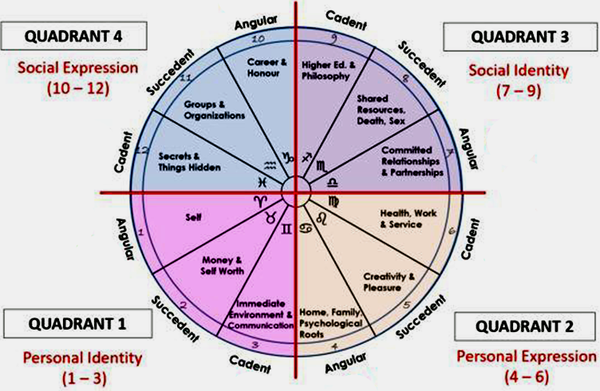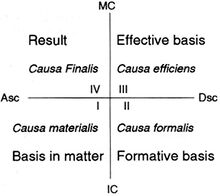Quadrant

Each horoscope can be easily divided into four parts. In an Equal house system grouping the houses 1-3, 4-6, 7-9, and 10-12 divides the chart into four euqal quarters. In Quadrant House Systems divided by the Ascendant/Descendant (AC/DC) and Medium Coeli/Imum Coeli (MC/IC) axes quadrants usually differ in size, their exact size depending on the place and time of birth. In Central Europe(around 50 degrees north latitude), the quadrants are the same size when the Ascendant is in the second half of Virgo or first half of Libra and in the opposing signs of Pisces and Aries.
In a natal chart reading, each quadrant has a different quality which arises from the division of the horoscope by the two main axes. Over the centuries, astrologers devised different interpretations of quadrant meanings, but they generally follow a logic based upon the meanings of the chart Angles. The AC/DC axis, for example, gives an above- and below-ground division, enabling the astrologer to distinguish a day birth from a night birth, depending upon the sun's hemisphere. East of the MC/IC axis planets are oriental, and are in a condition of rising towards their highest point in the sky. West of the line planets are western or occidental, and descend towards their lowest point in the horoscope.
Because different astrologers number the quadrants differently, it may be easiest to conceptualize them as "upper" vs. "lower" and "east" vs. "west" to minimize confusion.
Using the symbolism of the sun through the quadrants, traditional astrologers determined that the upper hemisphere indicated visible, public expression; whereas the lower hemisphere showed more private, hidden matters. East indicated active beginnings and initiative. The West showed, if not a state of decline, traits that were more passive and adaptable.
The top of a horoscope also indicates the direction south; and the bottom of the horoscope, north. Consequently, in putting together the compound meanings of the quadrants, traditional astrologers determined that the southeast quadrant, for example, was hot, moist, active, masculine, and symbolic of infancy.
Modern astrologers take different meanings from the nature of the chart angles. Due to its relation to the first house, the eastern Hemisphere of the horoscope is the personal hemisphere, whereas the western Hemisphere is the Relationship hemisphere in relation to the DS as the cusp of the 7th house. The top hemisphere, or "diurnal hemisphere", represents the individual's outer world, the bottom Hemisphere, or "nocturnal hemisphere", his inner world. Combining these meanings gives: the north- or lower east quadrant stands for the personal interior world; the lower west for the relationship interior; the upper west, for the relationship outer; and the upper east, one's personal exterior world.
The lower east quadrant represents themes which the self seeks to express directly. These themes are particularly apparent and cannot (or only with great effort) be suppressed. This quadrant is the most apparent to the outside world. The planetary energies in this quadrant actively shape the personality.
The lower west quadrant is about contact with others on an inner emotional level. This segment is therefore often described as the "soul quadrant". It represents themes and individual wishes to share with others in order to promote inner development.
The upper west quadrant is about direct contact with the outer world. It shows the kind of expectations a person has for relationships and how these can be realised in difficult times. It also stands for official contacts with others in society such as contracts. The third quadrant also expresses what has been learnt and integrated in the first two quadrants.

In the upper east quadrant, personal themes are expressed with the intention of influencing the public sphere. This quadrant goes beyond the development of personal potential as in the first quadrant. Personal insight is translated into the wish to influence the wider society. The fourth quadrant symbolises themes of a collective nature as opposed to the subjective qualities of the first quadrant. In order to be able to do this, the challenges of the first quadrant must first of all be met, otherwise the tasks faced in the fourth quadrant will remain unclear and ambiguous.
Because many people will have an emphasis on one quadrant in their charts, the quadrants suggest their principal orientation to life. An absence of planets in a quadrant may show that it is not a particular focus for them.
Bibliography
- Helena Avelar and Luis Ribeiro, 2010, On the Heavenly Spheres: A Treatise on Traditional Astrology, American Federation of Astrologers
- Hand, Robert, 1981, Horoscope Symbols, Whitford Press
Notes and References
- ↑ Illustration from Mindful Heart Astrology - Cadent Houses ("Soul Bridging")